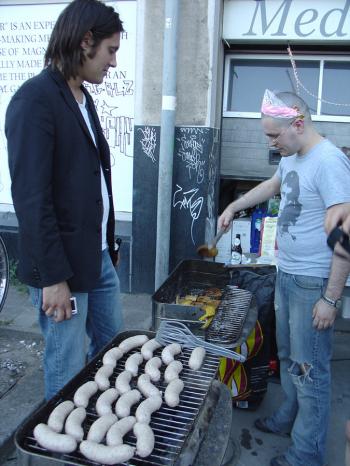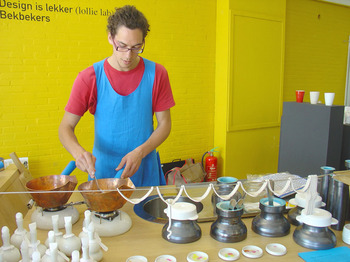Soy story: food subculture club visits an exhibiton of Romanian otaku culture
July 9, 2006

An array of Romanian textured soy products
What could be more obvious than the fact that the noble soybean, or rather, the humble hunk of textured soy and contemporary Romanian otaku culture are inextricably linked. You already knew that, right?
About one month ago, Mediamatic hosted a most unusual food-related exhibition about the intricate and vivid world of Romanian otaku. Otaku, a once Japanese, and now ubiquitous term for fanatic, refers to the group of people that live out the bulk of their social and cultural lives in social game spaces online. Artists Stefan Tiron (curator/artist), Bogdan Marcu (artist, musician) and Linda Barkasz (cosplayer/artist) playfully offered a glimpse of the inner workings of this subculture through a multi-media installation, comprised of costumes, hacked and remade computer animations, collections of manga literature, glittery stickers, sparkles, a replica of a Romanian otaku’s room, a goodly amount of oral history and a good old-fashioned BBQ featuring about as many Romanian soy products as anyone could stomach.

Stefan Tiron opens the Mediamatic BBQ and tells the Romanian textured soy story
To attempt to sketch the outlines of a living subculture through art (or the medium of BBQ for that matter) was an inspired move by curator Arne Hendriks. All the more so because in the selfsame building at the very same time, the Stedelijk Museum was hosting a flat and populistic exhibition about the role of art in online game culture, Next Level. Obviously I prefer an exhibiton initiated out of engagement with the creators of contemporary culture to an exhibition produced to increase visitor numbers amongst teenagers whether there’s a BBQ involved or not.

Curator Arne Hendriks and artist Bogdan Marcu converge. Sausage on the left, soy on the right

Artist Linda Barkasz tells Katerina the story of the Romanian otaku whose offline personality was in need of a boost and for whom she made this costume.
What I learned during this food subculture club outing is that although soy is probably only specifically important to these particular Romanian otaku, soy has certainly played an important role in Romanian cultural history. For realsies.

Henry Ford gives his soy car a whack, source unknown, image used entirely without permission
In the 1980’s, Romanian dictator Nicaolae Ceaucescu attempted to pay off his country’s debts to the World Bank by halting (food) imports to Romania. The country was to become self sufficient’ish’, especially in terms of food production. During this period, which the Romanian Otaku artists remember as young children (except for young Linda), there was widespread hunger, child abandonment and all manner of hunger-induced problems. While his folk starved to pay off the country’s debts, Ceaucescu decided to introduce an appropriately utopian foodstuff into the culture, one that would act as a beacon for its utopian future. What the heq is it about soy that just screams things can only get better? Henry Ford held soy in such high esteem that he designed a car out of it and in an enthusiastic and spontaneous publicity stunt to prove the soy-car’s sustainability, took an axe to the trunk.

At the Romanian otaku Soy Story BBQ, a father dishes up soy whilst his son uses clear body language to express his scepticism
On the other hand, if you want to be efficient about increasing your population’s protein intake, soy is a really good bet. But it wasn’t Ceacescu’s style to simply introduce a new bean and tell his people to get cookin’. He wanted a fully designed food product, a product that could represent progress and modernity. Unfortunately for the entire world, Ceacescu didn’t give the Romanians actual soybeans to play with (and from which you can make all manner of delicious foods) but an end product called textured soy, a foodstuff so highly processed and vile, that many people would rather go hungry (or build a car) than try to incorporate it into their food.
Artist Stefan Tiron remembers that in the late 1980’s, food in Romanian cities was so scarce that to attract customers, shopkeepers would make sculptures out of empty food packaging in their empty shops in the hopes of offering their customers something that resembled a consumer experience. Tiron told me that if it weren’t for the close ties that many city dwellers had with their relatives in the countryside (and for the presence of adhoc urban agriculture), the entire country would have starved to death. For those willing to bite the bullet, communinist party membership equalled access to animal protein and extremely humorous slang words emerged to describe the available cuts of meat. In a 1980’s Romanian version of the Omnivore’s Dilemma, Addidas meant pig’s feet and a computer was a pig’s head.

Unverified scene from the film Soylent Green, image source unknown and used entirely without permission
In a misguided attempt to expose the Romanian population to dystopic visions of Western culture, the underground cult film, Soylent Green (1973) was shown in mainstream cinemas all over Romania in the early 80’s. The movie’s title comes from the fictional industrial food product produced by the Soylent Corporation from plankton and soy. In the film, soylent green is essentially government produced hardtack, and one of only a few foods available. The relation between the film’s plot with the situation in the Heimatt was not at all lost on Romanian movie-goers. Angst is us!

A Romanian soy patĂ© brand called Angst, sports a 1930’s German typeface and a WWII blimp!
The connection between Romanian soy history and contemporary Romanian otaku culture is a stretch, and maybe it only exists by virture of this soy story and the oral history of these particular Romanian otaku, but artists Tiron and Barkasz insist that Ceacescu’s utopian fanaticism with textured soy laid the foundations for a youth culture that would, if not so much reject the physical world, at least embrace the online one most heartily. And maybe the online environment of the contemporary Romanian otakus offers a real alternative to the lack of housing for most homebound Romaninan twenty-somethings. For many young people still living at home, an online social life is a coherent option for autonomy and could explain the immense popularity of MMORPGs (massive multi-player online role playing games) in Romania. According to Barkasz, amongst these otakus the most popular subject, even in the fantastical world of online role-playing, is food. When Barkasz breached the subject of food on her blog early this year (entries January 6 - 30, 2006, in Romanian), readers flocked to tell their stories of eating at the computer and upload pictures of computer food moments.

Stefan Tiron hocks homemade sliwowitz, in a plastic PET bottle. Mind your eyes!

Mediamatic folks are no stranger to culinary experimentation and embrace the notion of making ’s mores with chopsticks and vegetarian marshmallows made from… soy.
- Romanian Otaku exhibition and BBQ: link at Mediamatic. This exhibition was held from June 11 - June 18, 2006 as part of a four-part series at the Mediamatic exhibition space.
- Soylent Green: The movie, set in New York City in the year 2022, depicts a future dystopia, a Malthusian catastrophe that takes place because humanity has failed to pursue sustainable development and has not halted population growth. The city’s population is 40,000,000, with over half unemployed. Global warming, air and water pollution have produced a year-round heatwave and a thin yellow smog in the daytime. Food and fuel resources are scarce, housing is dilapidated and overcrowded, and widespread government-sponsored euthanasia is encouraged as a means of reducing overpopulation. …The government dispenses rations of synthetic food substances made by the Soylent Corporation: Soylent Yellow, Soylent Red, and the newest product, Soylent Green, the most popular version derived, according to the Soylent Corporation, from plankton.
- Nicolae Ceaucescu according to Wikipedia: …In the 1980s, Ceaucescu ordered the export of much of the country’s agricultural and industrial production in order to repay its debts. The resulting domestic shortages made the everyday life of Romanian citizens a fight for survival as food rationing was introduced and heating, gas and electricity black-outs were becoming the rule. There was a steady decrease in the living standard (and especially the availability of food and general goods in stores) between 1980 and 1989. The official explanation was that the country was paying its debts, and people accepted the suffering, believing it to be for a short time only and for the ultimate good.
AND
…By 1989, Ceaucescu was showing signs of complete denial of reality. While the country was going through extremely difficult times with long bread lines in front of empty food stores, he was often shown on state TV entering stores jampacked with food supplies and praising the ‘high living standard’ achieved under his rule. In the fall of 1989, daily TV broadcasts were showing endless scrolling lists of CAPs (kolkhozes) with alleged record harvests, in blatant contradiction with the shortages experienced by the average Romanian at the time.Some people, believing that Ceaucescu was not aware of what was going on in the country, were attempting to hand him petition and complaint letters during his many visits around the country. However, each time he got a letter, he would immediately pass it on to members of his security detail. Whether or not Ceaucescu ever came to read any of them will probably remain an unsolved mystery. According to the rumors of the time, people attempting to hand letters directly to Ceaucescu had to take upon themselves a high risk of adverse consequences, courtesy of the secret police Securitate. People were strongly discouraged from addressing him and there was a general sense that things had reached an overall low.
- Franziska Nori, game curator at Frankfurt’s Museum of Applied Arts: digitalcraft is a project begun in 1999 by Frankfurt?s Museum of Applied Arts. Its purpose is to document fast-moving trends as they develop in our everyday digital culture. digitalcraft continues to expand a collection comprising a selection of contemporary and historically relevant artifacts within the realm of digital arts and crafts. The three areas of collection currently under development are games and emulators, website and a historic online community.
- Turning Games into a New Kind of Art’: that was the headline in The New York Times on January 21, of an article about a games exhibition ? and provides all the more proof that to an ever increasing degree digital games are part of popular culture. They not only reflect elements of daily life, but also influence it. BLA BLA BLA
- Otaku etymology: In modern Japanese slang, an otaku refers to an overly obsessive fan of any one particular theme, topic, or hobby. Perhaps the most common uses are anime otaku (one who sometimes enjoys many days of excessive anime watching with no rest) and manga otaku (a fan of Japanese graphic novels). The term otaku used by itself just means “fanatic”. Japanese culture has many other varieties, such as p?sokon otaku (personal computer geeks), g?mu otaku (playing video games), and otaku that are extreme fans of idols, heavily promoted singing girls. Sometimes the term would be used for some hobbies of mechanical or technological area such as tetsud? otaku (metrophiles) or gunji otaku (military geeks), too. While these are the most common uses of otaku, the word can be applied to anything (music otaku, martial arts otaku, cooking otaku, etc). The word maniakku or mania (from English “maniac”) is sometimes used to indicate someone whose interest is strong, but not obsessive or unhealthy: anime maniakku, gamu mania, etc.
- The politics of otaku: The basic idea is that the word is used to explicitly indicate detachedness from who you are speaking to. For example, a dedicated and experienced collector of cels will have a vast network of connections to aid in his or her search for rare cels. Many of these contacts will only be peripheral acquaintances (as opposed to members of one’s in-group). The relationships are business-like and not at all intimate. Although it’s still a bit strange, it makes a little more sense for someone in this type of social setting to call his or her acquaintances “otaku”. Idiosyncratically, perhaps, it also became common within the fandom community to call anyone who was a die hard fan/enthusiast/expert of something (not just anime, but anything) an otaku–not dissimilar to the popular American usage of the term.
debra at 18:13 | | post to del.icio.us















